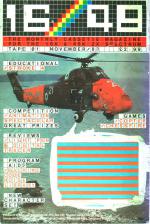
Crash
 1st October 1984
1st October 1984
Categories: Review: Magazine
Publisher: 16/48 Magazine
Machine: Spectrum 16K/48K
Published in Crash #9
Chris Passey takes a brief look at 16/48 Magazine - the July and August ssues (Nos. 9 and 10)
16/48 - The Magazine On Tape
Existing technology is often far harder to overturn than Utopia-mongers would like us to think. For many years the early railway carriages continued to resemble the old stage coach carriages of the roads, American philosopher Marshal McLuhan predicted the end of books - in a book. With the advent of teletext, one could be forgiven for thinking that the Radio and TV Times might have had their day - apparently, not yet. Equally the advent of the home computer has offered obvious opportunities for the production of computer magazines presented as software. Is it the end of the traditional paper magazine?
16/48 is a magazine on tape hence, due to its medium, it has certain advantages over the paper magazine and disadvantages. The fact that it costs £2.99 makes it the most expensive computer mag for the Spectrum! Is it worth this? Read on...
Each issue starts off with a quick look at the month's offerings (helpfully, this is duplicated on the cassette inlay card with space for writing tape counter readings). The contests tend to consist of the following: a couple of games (arcade, etc), editorial and letters, the odd educational program, an adventure plus adventure tips, machine code routines, brief reviews and a competition.
Don't expect the games to be of "Crash Smash" standard, but some are quite commendable. For example, Elevator in issue 9 is rather original and challenging with nice graphics. The editorial does not cover anywhere near as much as the average paper magazine. The educational games/utilities such as memory games using languages, and lens/ray calculations are fairly decent. Not being much of an adventurer I can only say that the adventure The Long Way Home is fairly typical but the 48K version has some excellent graphics.
What makes 16/48's adventure interesting is that it is a serial, a natural idea for a magazine like this. The adventure tips are a bit long winded to get at, but quite useful.
The machine code routines interested me; some are useful such as the screen magnifier, which I have tried out since. There is also a very good microdrive feature (but I suspect the writers think everyone has a microdrive).
But now onto the subject of reviews. I found these to be very shallow indeed. They basically say what the object of a game is with a very brief sort of opinion. There appear to be only about two per issue, but the screen pictures are the best I've ever seen - they are screen pictures!
I found that on each tape there were programs that interested me, and there were those that did not. this meant that to get a required bit I had to guess where it was (no tape counter). This can become a major drawback - access.
It's easy to have a quick flick through a paper magazine over breakfast, but 16/48 has to be loaded. Therefore it's not like a real magazine that you can pick up and read at leisure. On the other hand, because it is loaded you don't have to type in listings (if anyone still does)!
It's unlikely that you will be interested by every program in each issue of 16/48, so it's really up to the individual to decide whether it's worth the tag of £2.99 (I mean - can you see hardened arcaders playing Yahtzee?). For up to date news/views or reviews, the paper mag is still 'tops', but if you want a varied package as mentioned here, then it may well be of interest to you (and it'll be fun to see how well this review holds up in ten years time)!
16/48 magazine is published by 16/48 Magazine Ltd, Chiswick, London W4, monthly from all good news retail outlets, price £2.99.


